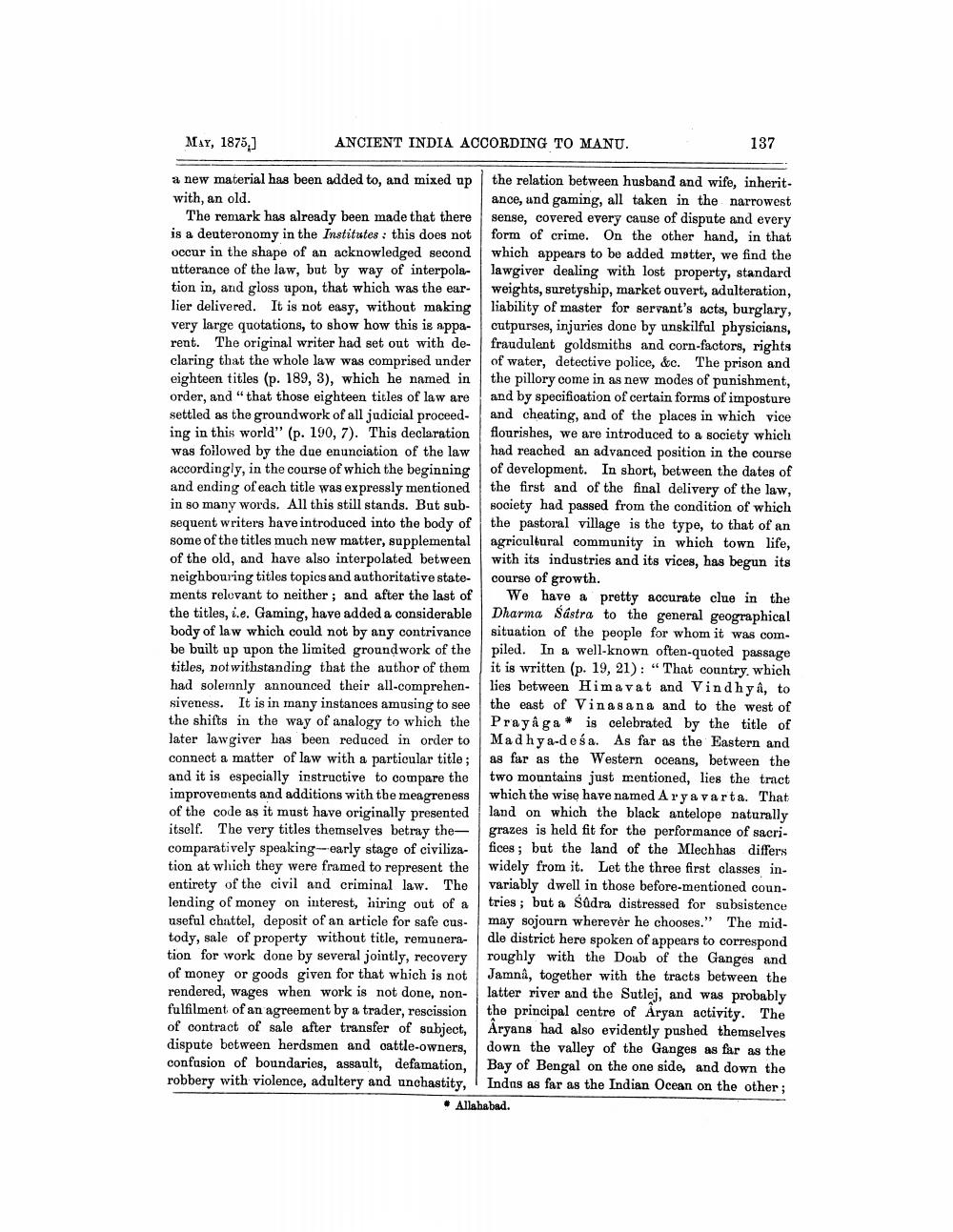________________
MAY, 1875,]
a new material has been added to, and mixed up with, an old.
ANCIENT INDIA ACCORDING TO MANU.
The remark has already been made that there is a deuteronomy in the Institutes: this does not occur in the shape of an acknowledged second utterance of the law, but by way of interpolation in, and gloss upon, that which was the earlier delivered. It is not easy, without making very large quotations, to show how this is apparent. The original writer had set out with declaring that the whole law was comprised under eighteen titles (p. 189, 3), which he named in order, and "that those eighteen titles of law are settled as the groundwork of all judicial proceeding in this world" (p. 190, 7). This declaration was followed by the due enunciation of the law accordingly, in the course of which the beginning and ending of each title was expressly mentioned in so many words. All this still stands. But subsequent writers have introduced into the body of some of the titles much new matter, supplemental of the old, and have also interpolated between neighbouring titles topics and authoritative statements relevant to neither; and after the last of
the titles, i.e. Gaming, have added a considerable body of law which could not by any contrivance be built up upon the limited groundwork of the titles, notwithstanding that the author of them had solemnly announced their all-comprehensiveness. It is in many instances amusing to see the shifts in the way of analogy to which the later lawgiver has been reduced in order to connect a matter of law with a particular title; and it is especially instructive to compare the improvements and additions with the meagreness of the code as it must have originally presented itself. The very titles themselves betray thecomparatively speaking-early stage of civilization at which they were framed to represent the entirety of the civil and criminal law. The lending of money on interest, hiring out of a useful chattel, deposit of an article for safe custody, sale of property without title, remuneration for work done by several jointly, recovery of money or goods given for that which is not rendered, wages when work is not done, nonfulfilment of an agreement by a trader, rescission of contract of sale after transfer of subject, dispute between herdsmen and cattle-owners, confusion of boundaries, assault, defamation, robbery with violence, adultery and unchastity,
137
the relation between husband and wife, inheritance, and gaming, all taken in the narrowest sense, covered every cause of dispute and every form of crime. On the other hand, in that which appears to be added matter, we find the lawgiver dealing with lost property, standard weights, suretyship, market ouvert, adulteration, liability of master for servant's acts, burglary, cutpurses, injuries done by unskilful physicians, fraudulent goldsmiths and corn-factors, rights of water, detective police, &c. The prison and the pillory come in as new modes of punishment, and by specification of certain forms of imposture and cheating, and of the places in which vice flourishes, we are introduced to a society which had reached an advanced position in the course of development. In short, between the dates of the first and of the final delivery of the law, society had passed from the condition of which the pastoral village is the type, to that of an agricultural community in which town life, with its industries and its vices, has begun its course of growth.
We have a pretty accurate clue in the Dharma Sastra to the general geographical situation of the people for whom it was compiled. In a well-known often-quoted passage it is written (p. 19, 21): "That country. which lies between Him avat and Vindhya, to the east of Vinasana and to the west of Prayaga is celebrated by the title of Madhya-desa. As far as the Eastern and as far as the Western oceans, between the two mountains just mentioned, lies the tract which the wise have named Arya varta. That land on which the black antelope naturally grazes is held fit for the performance of sacrifices; but the land of the Mlechhas differs widely from it. Let the three first classes invariably dwell in those before-mentioned countries; but a Sûdra distressed for subsistence may sojourn wherever he chooses." The middle district here spoken of appears to correspond roughly with the Doab of the Ganges and Jamnâ, together with the tracts between the latter river and the Sutlej, and was probably the principal centre of Aryan activity. The Aryans had also evidently pushed themselves down the valley of the Ganges as far as the Bay of Bengal on the one side, and down the Indus as far as the Indian Ocean on the other; * Allahabad.




